Fortune 100 Return To Office Policy Tracker [Feb 2024]
In this database, we keep an updated list of every “return to office” policy for the Fortune 100 (and compile the data at the top). Use the links below to jump to a section that interests you:
- RTO statistics and takeaways
- RTO for every Fortune 100
- Definitions
- Fortune 100s reducing office space
- 2023 & 2022 final statistics
Return To Office Statistics For The Fortune 100
According to primary research we conduct each month at Buildremote, here are the main takeaways of our study of the Fortune 100’s return to office policies:
|
Here are the return-to-office statistics for the Fortune 100 (updated monthly).
Remote Work Policies
How are Fortune 100 companies returning to the office?
- Hybrid: 75
- Office First: 6
- Remote First: 2
- Unknown: 16
See Also: The 70 Best Remote Companies To Work For
Office Visit Expectations
How many days per week do Fortune 100 companies expect employees to visit the office?
- None: 12
- 1 week/quarter: 1
- 1 day/week: 2
- 2 days/week: 2
- 50% of the time: 2
- 3 days/week: 21
- 4 days/week: 5
- 5 days/week: 9
- Unknown: 46
Return To Office Year
When are the Fortune 100 companies returning to the office?
- 2020: 1
- 2021: 11
- 2022: 23
- 2023: 16
- 2024: 9
- Yet to be determined: 14
- No official return: 5
- Unknown: 21
Fortune 100: Every Return To Office Policy
You’ll see information about the company – Fortune 100 rank and number of employees – and about their plans for a return to the office – the current date to call employees back in person, previous postponed dates, and the company’s policy on remote work.
Want to download this database?
Company | RTO Date | Post- | Remote Policy | Office Visit Expectations | Employees |
Walmart | August 2020 | Hybrid | 2 days/week | 2,300,000 | |
Amazon | October 2021 (No Official Return) | Hybrid | 3 days/week | 1,298,000 | |
Apple | 1 day/week: | June 2020 | Hybrid | 3 days/week | 147,000 |
CVS Health | Jan 2022 | Hybrid | 2 days/week | 256,500 | |
UnitedHealth Group | Jul 2021 | Hybrid | 3 days/week | 330,000 | |
Berkshire Hathaway | Unknown | Unknown | 360,000 | ||
McKesson | Unknown | Hybrid | Unknown | 70,000 | |
Amerisource Bergen | September 13, 2021 | Remote First | None | 21,500 | |
Alphabet (Google) | April 4, 2022 | Hybrid | 3 days/week | 135,301 | |
Exxon Mobil | - | Hybrid | 5 days/week | 72,000 | |
AT&T | February 2022 | Hybrid | 3 days/week | 230,760 | |
Costco Wholesale | 3 days/week | 214,500 | |||
Cigna | Hybrid | None | 72,963 | ||
Cardinal Health | Unknown | - | Hybrid | Unknown | 48,000 |
Microsoft | October 2021 | Hybrid | 50% | 163,000 | |
Walgreens Boots Alliance | Unknown | 277,000 | |||
Kroger | Hybrid | 3 days/week | 465,000 | ||
Home Depot | January 3, 2022 | September 2021 | 4 days/week | 504,800 | |
JPMorgan Chase | September 2020 May 2021 | Hybrid | 5 days/week | 255,351 | |
Verizon | September 2021 | Hybrid | Unknown | 132,200 | |
Ford Motor | January 2022 | Hybrid | 3/days week | 186,000 | |
General Motors | September 24, 2022 July 1, 2021 | Hybrid | 3 days/week | 155,000 | |
Anthem | Unknown | Unknown | 83,400 | ||
Centene | Hybrid | Unknown | 71,300 | ||
Fannie Mae | Unknown | Hybrid | None | 7,700 | |
Comcast | September 2022 April 2022 | Hybrid | 4 days/week | 168,000 | |
Chevron | January 2022 | Hybrid | 3 days/week | 47,736 | |
Dell Technologies | September 2021 | Hybrid | 3 days/week | 158,000 | |
Bank of America | January 2022 | Office First | 3 days/week | 212,505 | |
Target | September 2021 | Hybrid | None | 409,000 | |
Lowe's | - | Hybrid | 3 days/week | 280,000 | |
Marathon Petroleum | Unknown | Hybrid | Unknown | 57,900 | |
Citigroup | March 2022 January 2022 February 2022 | Hybrid | 3 days/week | 210,153 | |
Meta (Facebook) | January 2022 March 2022 | Hybrid | 3 days/week | 58,604 | |
United Parcel Service | September 2021 | Office First | 5 days/week | 408,255 | |
Johnson & Johnson | - | Hybrid | 1 day/week | 134,500 | |
Wells Fargo | September 2021 | Hybrid | 3 days/week | 268,531 | |
General Electric | - | Hybrid | Unknown | 184,000 | |
State Farm Insurance | July 1, 2021 | - | Hybrid | Unknown | 57,582 |
Intel | December 2021 | Hybrid | None | 110,600 | |
Humana | September 2021 | Hybrid | Unknown | 48,700 | |
International Business Machines (IBM) | September 2021 January 2022 | Hybrid | 3 days/week | 364,800 | |
Procter & Gamble | June 2021 | Hybrid | Unknown | 99,000 | |
PepsiCo | June 2021 | Hybrid | None | 291,000 | |
FedEx | Hybrid | 3 days/week | 418,000 | ||
MetLife | January 2022 | Hybrid | Unknown | 46,500 | |
Freddie Mac | Unknown | Unknown | 6,922 | ||
Phillips 66 | Hybrid | Unknown | 14,300 | ||
Lockheed Martin | - | Hybrid | Unknown | 114,000 | |
Walt Disney | January 9, 2023 | July 5, 2021 | Hybrid | 4 days/week | 203,000 |
Archer Daniels Midland (ADM) | July 2021 | Hybrid | None | 38,332 | |
Albertsons | Unknown | Hybrid | Unknown | 270,000 | |
Valero Energy | May 1, 2020 | - | Hybrid | Unknown | 9,964 |
Boeing | Office First | 5 days/week | 141,000 | ||
Prudential Financial | September 2021 | Hybrid | Unknown | 41,671 | |
HP | Unknown | Hybrid | Unknown | 53,000 | |
Raytheon Technologies | May 2021 | Hybrid | Unknown | 181,000 | |
StoneX | Unknown | Unknown | 2,950 | ||
Goldman Sachs Group | June 2021 January 2022 February 2022 | Office First | 5 days/week | 40,500 | |
Sysco | Unknown | Unknown | 57,000 | ||
Morgan Stanley | September 2021 January 2022 | Office First | 5 days/week | 68,097 | |
HCA Healthcare | Office First | 5 days/week | 235,000 | ||
Cisco Systems | July 2021 | Hybrid | None | 77,500 | |
Charter Communications | Unknown | Unknown | 96,100 | ||
Merck | - | Hybrid | Unknown | 73,500 | |
Best Buy | Hybrid | 3 days/week | 81,600 | ||
New York Life Insurance | Unknown | Unknown | 11,506 | ||
AbbVie | July 2021 | Hybrid | 5 days/week | 47,000 | |
Publix Super Markets | Unknown | Unknown | 227,000 | ||
Allstate | - | Remote First | None | 42,010 | |
Liberty Mutual Insurance Group | September 2021 | Hybrid | None | 45,000 | |
American International Group | - | Hybrid | Unknown | 45,000 | |
Tyson Foods | - | Hybrid | Unknown | 139,000 | |
Progressive | Hybrid | Unknown | 43,326 | ||
Bristol-Myers Squibb | July 2021 | Unknown | 30,250 | ||
Nationwide | No Official Return | April 2020 | Hybrid | Unknown | 25,391 |
Pfizer | - | Hybrid | 50% | 78,500 | |
Caterpillar | Unknown | Hybrid | Unknown | 97,300 | |
TIAA | - | Hybrid | Unknown | 14,953 | |
Oracle | Hybrid | Unknown | 135,000 | ||
Energy Transfer | Unknown | Unknown | 11,421 | ||
Dow | April 25, 2022 | - | Hybrid | None | 35,700 |
American Express | January 2021 | Hybrid | 1 day/week | 63,700 | |
General Dynamics | Unknown | Unknown | 100,700 | ||
Nike | December 2021 | Hybrid | 4 days/week | 75,400 | |
Northrop Grumman | - | Hybrid | Unknown | 97,000 | |
USAA | May 2020 February 2021 | Hybrid | 4 days/week | 35,935 | |
Deere | Hybrid | 4 days/week | 69,634 | ||
Abbott Laboratories | July 2021 | Hybrid | Unknown | 109,000 | |
Northwestern Mutual | July 2021 | Hybrid | Unknown | 6,641 | |
Dollar General | Unknown | Unknown | 158,000 | ||
Exelon | Unknown | Unknown | 32,340 | ||
Coca-Cola | September 2021 | Hybrid | Unknown | 80,300 | |
Honeywell International | February 10, 2022 | Hybrid | 3 days/week | 103,000 | |
Thermo Fisher Scientific | Hybrid | Unknown | 84,362 | ||
3M | - | Hybrid | None | 94,987 | |
TJX | September 2021 | Hybrid | Unknown | 320,000 | |
Travelers | January 18, 2022 | Hybrid | 3 days/week | 30,294 | |
Capital One Financial | September 2021 November 2021 | Hybrid | 3 days/week | 51,985 | |
Tesla | July 2021 | Office First | 5 days/week | 70,757 |
Sources
- RTO dates with a link: These are public sources of information (new stories)
- RTO dates without a link: These are anonymous tips from verified employees (not public)
We keep individual, updated pages for the following companies. For each company, you’ll find the full RTO timeline of postponements, quotes from leadership, whether they are buying or selling office space, and more.
- Ford
- Apple
- Microsoft
- Amazon
- Morgan Stanley
- Bank of America
- Goldman Sachs
- JPMorgan Chase
- Wells Fargo
- John Deere
Want to see some other related research reports?
- Every Notable Company Reducing Office Space
- Every Major CEO Stepping Down
- The Companies That Own Everything
Return To Office: Definition & Policy Descriptions
Return to office: A “return to office” date is the day in which a company has announced it will expect employees to show up in-person for work after being temporarily allowed to work remotely.
Here’s how we define the remote policies listed in the fourth column.
- Office First: The processes required to work in an office lead the company’s operations, with remote processes coming second. The company’s policy is to default to office-based interactions.
- Remote First: The processes required to work remotely lead the company’s operations, with in-office processes coming second.
- Fully Remote: The company does not have any physical office locations.
- Hybrid: The company plans to have employees working from home part of the time and in an office part of the time. Or, employees can choose to work from home or the office. (There are 14 hybrid schedules being tested by companies right now.)
In column five, you’ll see “Office Visit Expectations” (where we list the most common expectation at the company, if there are different expectations depending on the department or role):
- 1 day/week – 5 days/week: The number of days per week employees need to be in the office.
- 50%: Employees are expected to spend half of their time in the office.
- None: The company has publicly stated its policy and does not expect a certain amount of office visits per week.
- Unknown: The company has not publicly stated its office visit expectations for employees.
Notable Companies That Are Cancelling Office Leases
Some companies are downsizing outright canceling office space. Here is a list of some notable Fortune 100 companies doing just that.
- Intel (San Jose, California)
- Geico (California, statewide)
- Amazon (Bellevue, Washington)
- JPMorgan Chase (New York City, New York)
- Wells Fargo (New York City, New York)
- Citigroup (San Francisco, California)
- Target (Minneapolis, Minnesota)
- Oracle (left the Bay Area for Texas)
- State Farm (countrywide)
- AT&T (San Ramon, California)
- Nationwide (country-wide)
- Liberty Mutual Insurance Group (Washington & Texas)
See the full list of companies reducing office space.
Return To Office – 2023 Final Statistics
Here are the return-to-office statistics for the Fortune 100 at the end of 2023.
According to primary research we conduct each month at Buildremote, here are the final statistics for the return-to-office trend as of December 2023.
|
Here are the return-to-office statistics for the Fortune 100 (updated monthly).
Remote Work Policies
How did Fortune 100 companies return to the office by the end of 2023?
- Hybrid: 77
- Office First: 5
- Remote First: 2
- Unknown: 16
See Also: The 70 Best Remote Companies To Work For
Office Visit Expectations
How many days per week did Fortune 100 companies expect employees to visit the office at the end of 2023?
- None: 13
- 1 day/week: 2
- 2 days/week: 2
- 50% of the time: 2
- 3 days/week: 21
- 4 days/week: 5
- 5 days/week: 7
- Unknown: 48
Return To Office Year
When did the Fortune 100 companies return to the office at the end of 2023?
- 2020: 1
- 2021: 12
- 2022: 25
- 2023: 16
- 2024: 4
- Yet to be determined: 15
- No official return: 5
- Unknown: 20
Return To Office – 2022 Final Statistics
Here are the return-to-office statistics for the Fortune 100 at the end of 2022.
According to primary research we conduct each month at Buildremote, here are the final statistics for the return-to-office trend as of December 2022.
|
Remote Work Policies
How are Fortune 100 companies returning to the office?
- Hybrid: 76
- Office First: 5
- Remote First: 2
- Unknown: 17
Office Visit Expectations
How many days per week do Fortune 100 companies expect employees to visit the office?
- None: 18
- 1 day/week: 2
- 2 days/week: 1
- 50% of the time: 1
- 3 days/week: 15
- 5 days/week: 8
- Unknown: 55
Return To Office Year
When are the Fortune 100 companies returning to the office?
- 2022: 34
- 2021: 17
- 2020: 1
- Yet to be determined: 17
- No official return: 7
- Unknown: 24
Is one of our policies out of date?
We have a recurring task to update every policy once per month, but we may have missed an announcement in the interim. If one of our policies is out of date, please fill in the form on this page to let us know. We’ll follow up through email and then update the table right away (and give you credit if you’d like).
We hope you find this article useful. Just so you know, Buildremote may collect a small share of sales from the links on this page to help keep this site running.

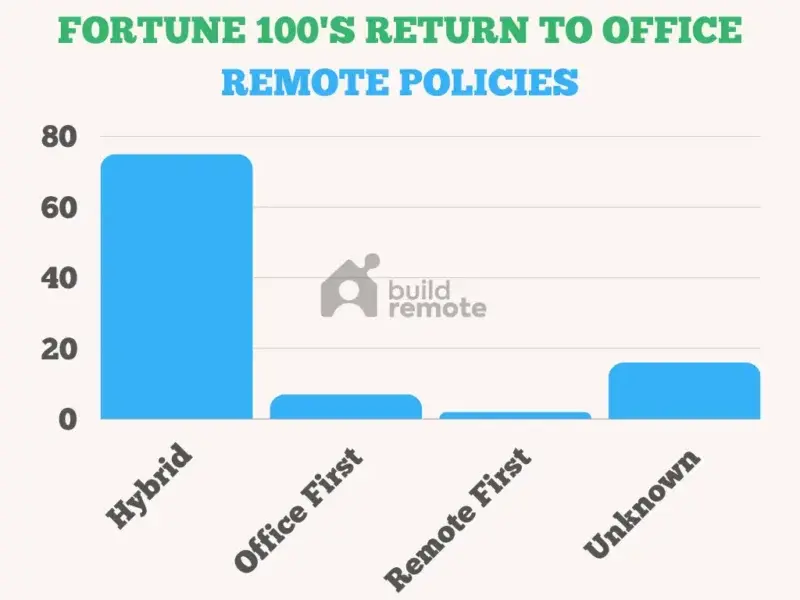
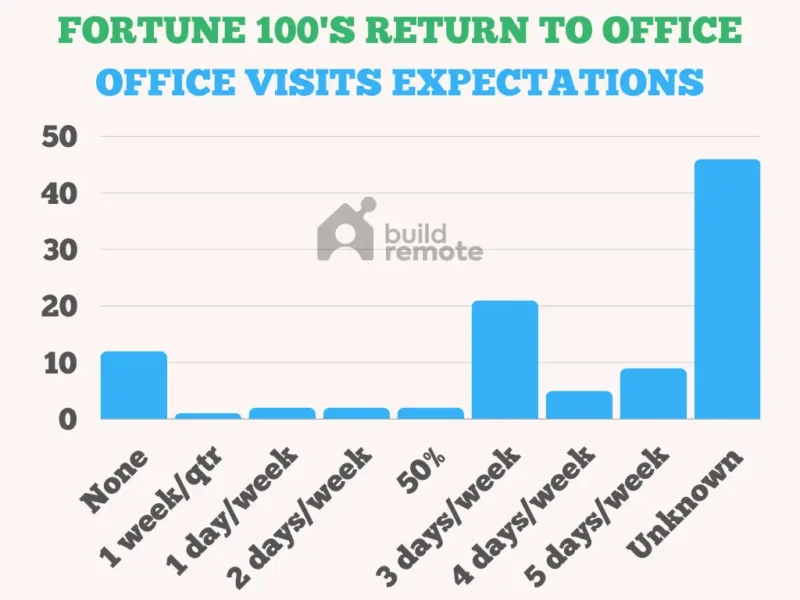
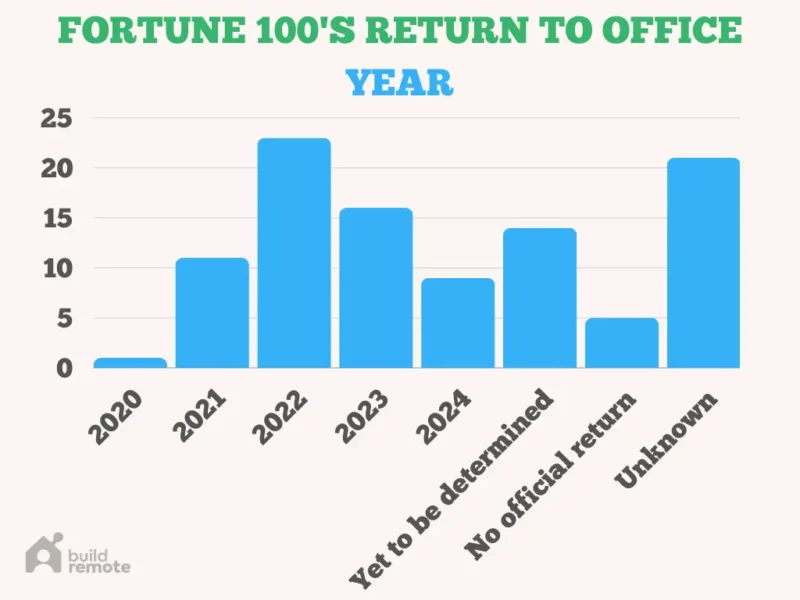




































































































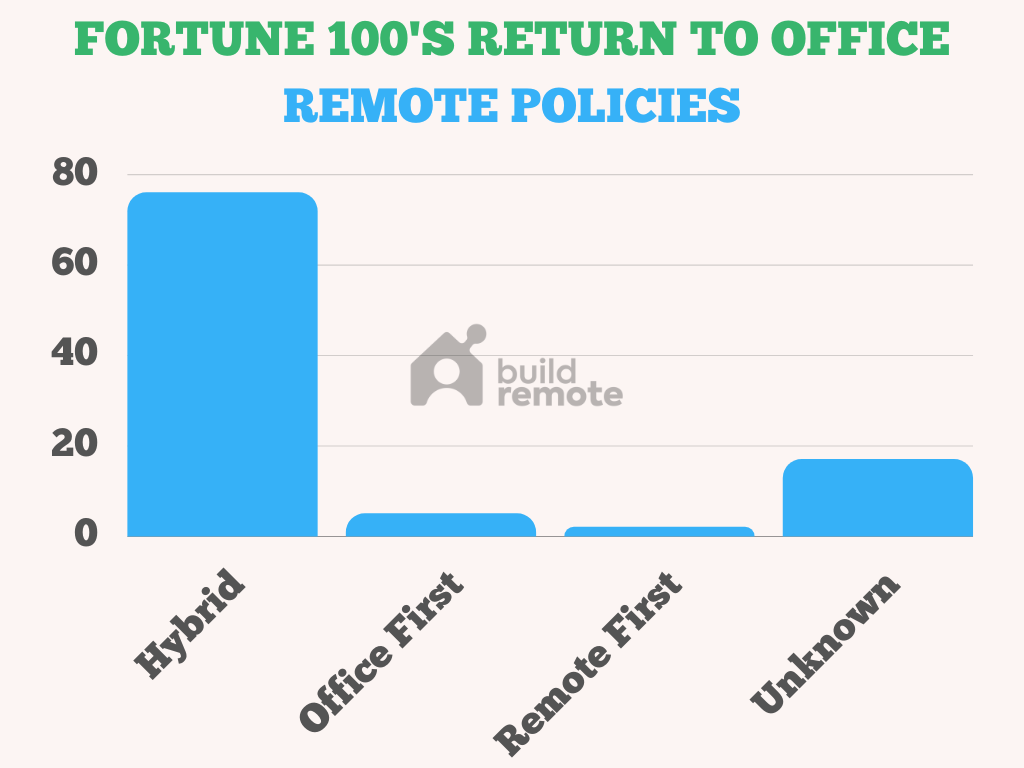
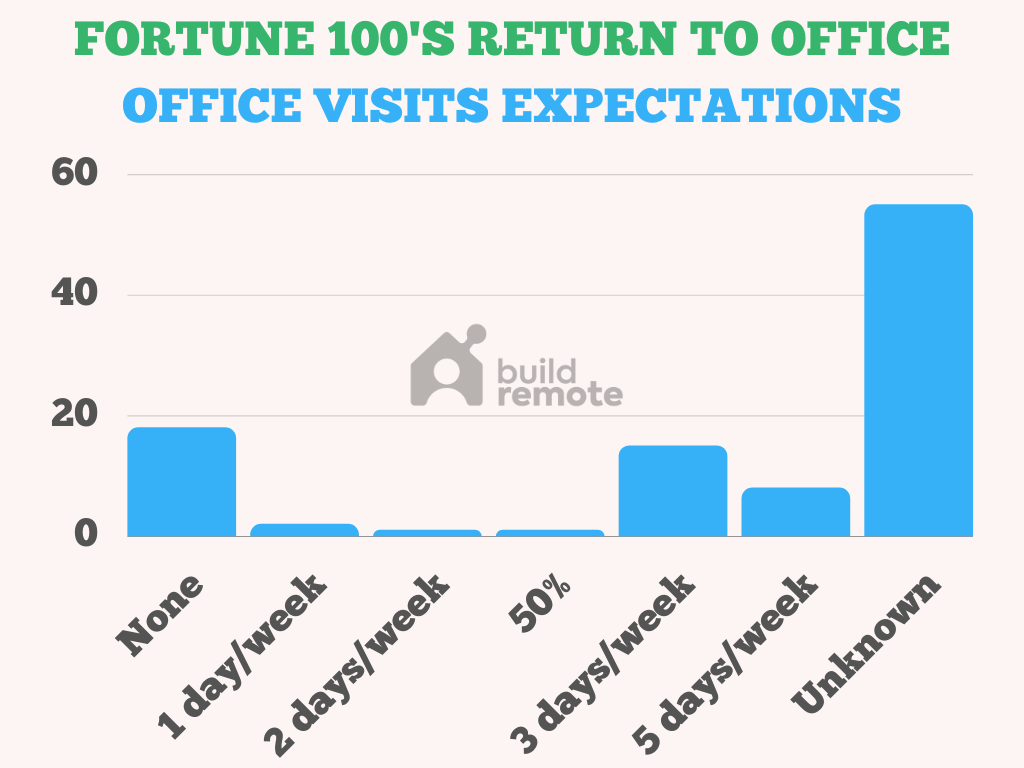
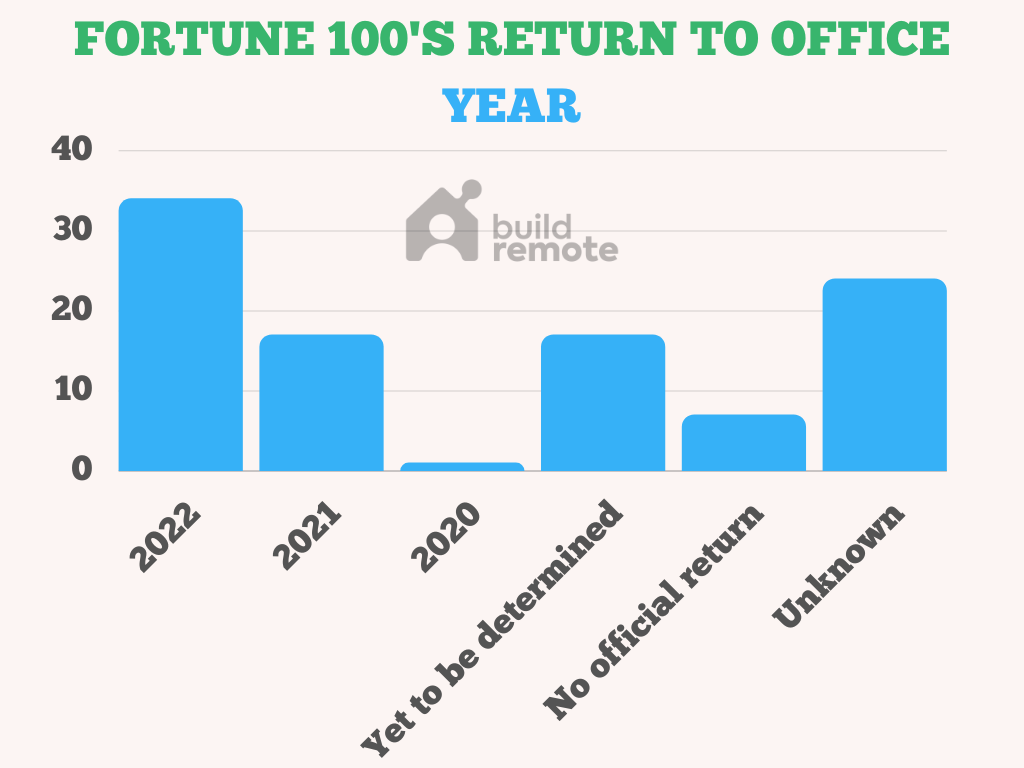
![Pinterest Image - Return To Office Policies For Every Fortune 100 [Sep 2023]](https://buildremote.co/wp-content/uploads/2023/09/return-to-office-policies-for-every-fortune-100-september-2023-buildremote-pinterest.png)
I know this is only about Fortune 100, but American Airlines (ranked 114) is also reducing WFH for it’s tech employees later this year
Costco just announced RTO 3 days today
Thanks for letting me know.
Abbott Laboratories just announced RTO 5 days January 2024 today, and are no longer hybrid.
Thanks, Bill. I emailed you to gather some proof before I publish it.
Great insights, Henry. Thank you for aggregating this info. What are your go-to sources for these updates?
I have a few different ways: 1) Google Alerts (news stories that mention specific keywords), 2) people directly contacting me with their company updates, 3) research when Google searches for specific companies spike on my site (like this: https://buildremote.co/return-to-office/john-deere/).
#1 is grunt work. #2 and #3 have become sort of proprietary to my site.